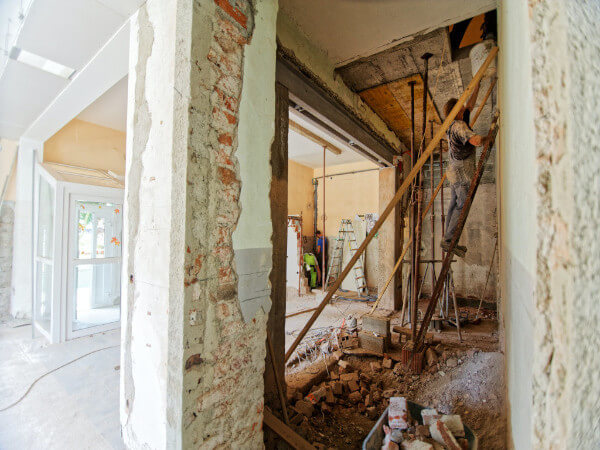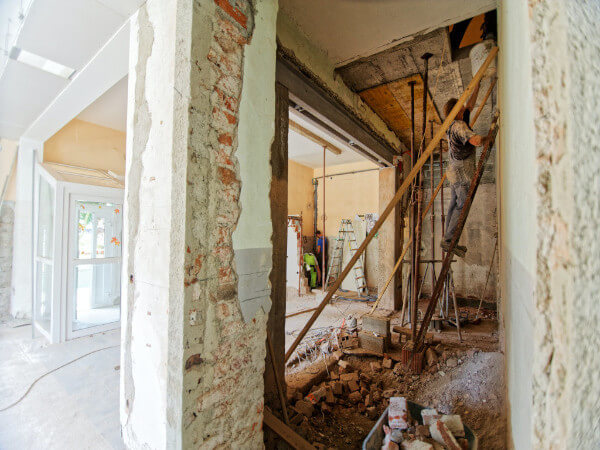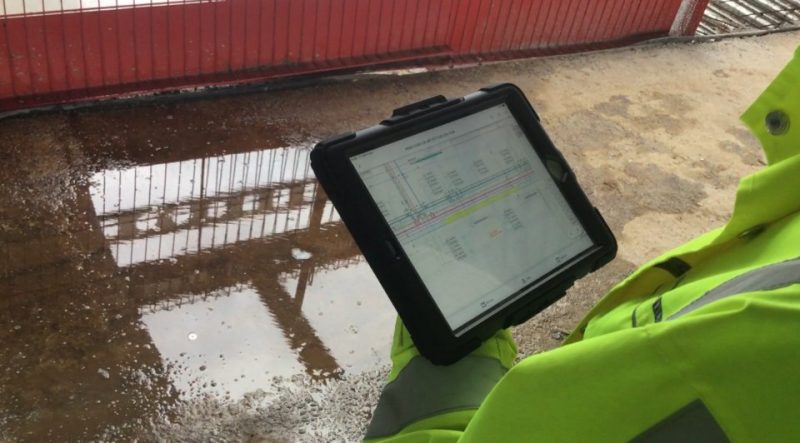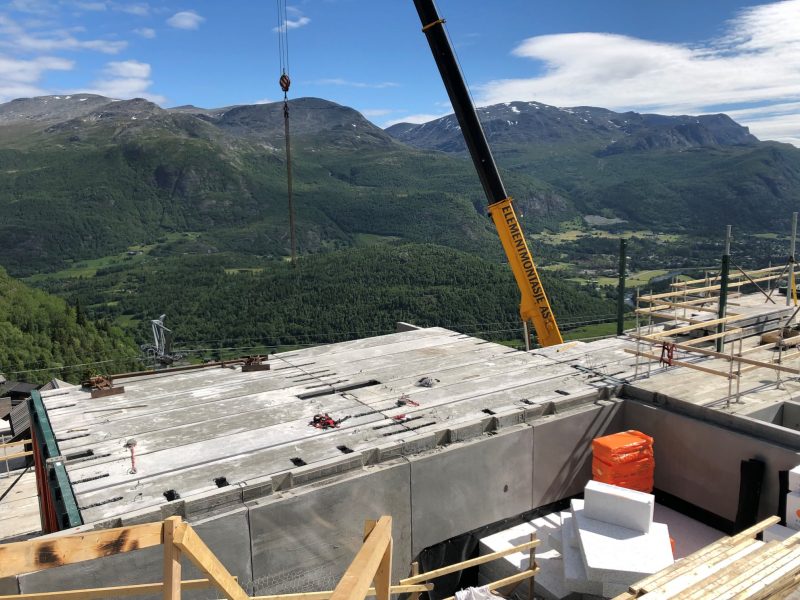These past 18 months have challenged contractors across the globe in more ways that anyone could have imagined. Managing pandemic disruptions and getting projects over the finish line has required a well-tempered balance of leadership, creativity, and innovation to solve incredibly challenging problems. If the resilience seen this year has shown construction professionals anything, it’s that this industry, and the people who work in it, are remarkable.
One of the greatest things about AEC is how many talented people contribute to a single project. It’s the people serving this great industry that we are here to celebrate. The people who continue to see opportunity where others see challenge, and should be recognized for a job well done in 2021. Whether you’re pouring concrete or tracking project costs, it’s a powerful thing when so many people can point to a single project and say, “we did that.” There’s nothing like AEC, and this year’s 40 Under 40: Champions of Construction have demonstrated their ability to inspire, educate, and advance the industry in ways worth admiring.
Every year, Autodesk receives hundreds of nominations for this program from across the globe, representing thousands of years of AEC industry experience. Narrowing the list down is not a task we take lightly, and I’m proud to share Autodesk’s 2021 40 Under 40: Champions of Construction
40 Under 40: Champions of Construction 2021
The list appears in alphabetical order by company/organization name. Click on a name to jump to the individual, or scroll on.
Nima Jafari, AmazonJustin Maryak, Auld & White ConstructorsKaty Johnson, Balfour Beatty ConstructionJonathon Feldotte, Barton Malow CompanyChristian Franz Hammerl, Bremer AGJessica Henri, Canadian Turner ConstructionGiana Morini, DPR ConstructionChristine Joy T. Asiatico, EEI CorporationAdolfo Gutierrez Sanchez, Ferrovial ConstructionChristian Paul, Gilbane Building CompanyDarrah Leach, Granger ConstructionIsabel Harlan, Hatch LTKKyle Spitznagel, Hathaway Dinwiddie Construction CompanyAndrew Cameron, Hensel PhelpsDwayne Jeffery, Howard S. Wright (a Balfour Beatty Company)Brady McKinney, Huston ElectricYoanna Ruseva, ISGMarcus R. Thomas, KEi ArchitectsAhmad ElMani, KEO International ConsultantsAmira ElSaeed, Khatib & AlamiYesenia Rivera Martinez, Largo Concrete, Inc.Jessica Allin, Ledcor Construction LimitedBrant Fischer, Messer ConstructionJay Mathes, Miron ConstructionEoin Prunty, O’Mahony Pike ArchitectsRyuji Taniguchi, Obayashi CorporationKarina Delcourt, OmicronLou Varni, Pankow BuildersSarah Watte, Phoenix Civil Engineering, IncCaleb Wohletz, Precision Precast Erectors, LLCMatthieu Desvignes, SanergyWilliam Senner, Skanska USAMark LaBell, SSOE GroupDerek Mosiman, SwinertonTimothy Jarvey, The Neenan CompanyMarcus Kratz, The Tri-M Group, LLCAdam Derx, The Walsh GroupKristopher Dane, Thornton TomasettiBetsy Bice, Truebeck ConstructionDakota Clifford, Virginia Department of Transportation
1. Nima Jafari

Senior BIM Manager
Amazon
Verona, New Jersey
Regarded as a pioneer of BIM technology at Amazon, Nima Jafari currently serves as the company’s Regional Senior BIM Manager, where he’s building the Emerging Technologies Department in Amazon TES from the ground up. Nima also plays an important role in building new distribution centers and sortation centers— a critical part of the business, particularly as Amazon continues to innovate and expand.
Nima is no stranger to BIM. Prior to Amazon, he was the Senior BIM-VDC Manager at Schiavone Construction Co. LLC, a firm that focuses on complex, fast-paced, and heavy construction projects like the award winning East Side Access Project (Grand Central Terminal) and 2nd Ave Subway expansion.
He’s tackled several impressive construction jobs throughout his career. He was the lead BIM Coordinator for the Hudson Yard project in Manhattan, Coordinated the MEP utilities for the Potomac Yard Metrorail Station Project (Washington DC), Science Building Rehabilitation in West Point and 86th Street Subway Station.
“He is never afraid of facing any kind of complications and finds solutions with minimal losses. In my opinion, he is the pioneer of BIM technologies for Amazon and I am sure it will only benefit his employer.”
2. Justin Maryak

Director of Project Management and Division Leader
Auld & White Constructors
Jacksonville Beach, Florida
Justin Maryak is the Director of Project Management and Division Leader at Auld & White Constructors (AWC), where he oversees the direction and leadership of project execution for the firm.
A graduate of the Georgia Institute of Technology, Justin is passionate about the AEC industry, and he strives to do what is best for his clients and community. Because of his leadership and dedication, Justin has quickly risen through the ranks of AWC.
With more than 17 years of experience, Justin has been instrumental in the success of a wide range of projects in the commercial, institutional, and healthcare sectors. The projects he has overseen have ranged from $150,000 to $33 million.
Some of the notable projects Justin has worked on include the Baptist Medical Center, the North Florida School of Special Education, and the American Cancer Society Hope Lodge at Mayo Clinic.
In addition to overseeing numerous projects, Justin has also been a champion of construction technology at AWC. He encouraged the firm to adopt new platforms that would enable teams to communicate better and resolve issues more efficiently. Because of his work, the teams at AWC have improved day-to-day productivity and have seen massive time savings.
“With his forward-thinking mindset, he continually explores innovative ideas and processes. Then, he incorporates those into best practices to empower his team to work more effectively and efficiently.”
3. Katy Johnson

Senior Construction Project Manager
Balfour Beatty Construction
San Diego, California
As the Senior Construction Project Manager at Balfour Beatty, Katy runs multiple projects at once. She ensures teams are aligned, clients are happy, and projects are delivered on time and within budget. Katy has done a tremendous job engaging clients and cultivating strong relationships that have resulted in securing long-term contracts. Her leadership skills, along with her professional yet engaging personality, make her a joy to work with.
Katy is incredibly dedicated, and she’s been with Balfour Beatty Construction for more than 15 years. She was an early employee at the company and one of her key accomplishments has been helping Balfour Beatty level up their construction technology.
In addition to overseeing projects, Katy is highly involved in initiatives that promote social good. She’s part of various internal groups within the organization, including the Diversity, Equity, and Inclusion committee, and notably a board member on both the Connecting Women and Building PRIDE affinity groups.
Katy’s drive, leadership, and compassion make her a truly inspiring figure not just in Balfour Beatty, but in the AEC industry.
“Katy has a very high level of patience and professionalism. She’s a helpful leader who pays attention to the needs of the team, the client, and the company. She also has a great sense of humor and the ability to turn difficult conversations into friendly ones.”
4. Jonathon Feldotte

Vice President of Preconstruction & Work Acquisition
Barton Malow Company
Southfield, Michigan
Jonathon started as a Project Engineer at Barton Malow and worked his way up to Vice President in just 10 years. He established new and innovative processes that helped the firm increase customer satisfaction and win more work. With his help, Barton Malow surpassed its revenue goals, despite the global pandemic. The industrial side of the business, which closed out 2019 at $750 million, generated $1.2 billion in 2020.
Jonathon is also a champion of technology, and he has led several digital transformation initiatives that enabled Barton Malow to keep up with the pace of change in the industry. Thanks to his leadership in the adoption of the latest construction technology, the firm is poised to remain on the cutting edge in a rapidly evolving industry.
Beyond his work in improving the technology and processes at Barton Malow, Jonathon cites employee development and community engagement as personal achievements. He’s helped create new jobs and enabled the firm to retain top talent by creating an environment where employees can thrive.
To top things off, Jonathon also leads Barton Malow’s volunteer efforts that support local workforce development and fundraising initiatives for charities in the area.
“Jonathon’s goal is to transform the image of the construction industry from one that over-promises and under-delivers to one that embraces technology and delivers quality work on budget and on time.”
5. Christian Franz Hammerl

VDC/BIM Manager
Bremer AG
Germany
As VDC/BIM Manager at Bremer AG, Christian leads a part of the firm’s innovation team in finding the right tech solutions, managing IT, and educating internal teams on how to leverage construction technology.
Chrisitan is currently executing his vision for digital transformation at Bremer. This year, he introduced and established a company-wide common data environment (CDE) that would enable teams and partners to have better access to information so they can stay in sync. For this purpose, he developed and programmed an interface website as middleware between many internal and external services, such as BIM360, in order to integrate them seamlessly into the historically grown IT infrastructure at Bremer.
He’s also working on several initiatives, including implementing technology across all construction sites for Bremer’s team and project leads, as well as improving collaboration through digital tools.
Christian is truly an asset at Bremer, and there’s no doubt that he will continue to take the company’s tech initiatives to new heights.
“Christian leads a part of the innovation team to evaluate solutions and manages the IT administration. He’s led the company through many different digital transformations and communicates his vision clearly.”
6. Jessica Henri

Project Manager
Canadian Turner Construction
Vancouver, British Columbia
Only one word comes to mind when colleagues describe Jessica: leader. As Project Manager at Canadian Turner Construction, she constantly steps into leadership roles both within the company and in the projects she oversees.
Jessica has been involved in various jobs, ranging from $20 to $60 million, and she’s also been part of three of Turner Vancouver’s largest projects to date.
She is known for supporting innovation and developing strong working relationships with clients, consultants, and contractors. Her teams are even recognized for being high-performing, cohesive, and innovative—a testament to her strong leadership style.
A great example of one of the challenging projects she has recently managed involved the construction of a new power plant for a local hospital. The project required a live and seamless switchover from an existing facility power plant to a newly constructed power plant without stopping or impacting hospital activities. Jessica was able to navigate the complex coordination between the hospital stakeholders, consultants, and trade contractors to deliver a successful project without impacting the hospital and its patients.
Jessica has demonstrated strong leadership and project management skills, which is why it’s no surprise that she’s been selected as the manager for these large, complex projects at her firm.
“Jessica’s top-tier technical expertise, problem-solving abilities, and organization, combined with the kindness, fairness, and diplomacy she demonstrates on a daily basis, make her one of the best champions of construction I’ve had the pleasure to work with.”
7. Giana Morini

National Operations Technology Leader
DPR Construction
Ashburn, Virginia
Supporting the AEC industry for more than 15 years, Giana uses her knowledge and skills to promote both innovation and social good across projects. Leveraging those skills she has built a career, currently serving as the National Operations Technology Leader at DPR Construction.
Giana started her career in civil and structural engineering, working on both domestic and international programs. For ten years she delivered significant projects, proving her construction prowess and gaining experience across the engineering and construction industry. During this time Giana also supported Engineers Without Borders USA where she oversaw a team of 25 to develop a water storage system for a village in northwestern Thailand. This combined experience provided the foundation for Giana’s transition into a technology and innovation role, where she focused on digitalizing the engineering and construction industry.
Today, at DPR, Giana works with multiple stakeholders across our organization to determine which technologies the company should invest in, adapt, and implement across the enterprise. She leads a continuously growing team that supports all field operations, self-perform work, risk, insurance, safety, and quality enterprise technologies.
Giana has already created a lasting impact at DPR, bringing processes and standardization to the way the organization evaluates and implements technology. Through her leadership, this team ensures DPR has cross-work group process alignment and takes a programmatic approach, strategizing to find and implement new technologies that ensure DPR’s implementation meets the needs of its customers. Her biggest accomplishment to date has been baselining the approach, so that DPR can provide consistent delivery with repeatable results for technology solutions and deployments. Giana is currently supporting DPR’s approach to evaluating Autodesk products to execute projects more efficiently.
Beyond her professional life, Giana is a proud wife and mother of two, soon to be three.
“Giana is deeply passionate about construction technology at a strategic level. Her level of detail and understanding (both high and low) of how each application connects or should connect blows me away. To me, she’s truly a champion for all user levels at DPR.”
8. Engr. Christine Joy T. Asiatico, MSCM

Group Supervisor
EEI Corporation
Metro Manila, Philippines
To say that Christine cares about the success of her teams through digital transformations would be an understatement. She recognizes that rolling out technology initiatives is 90% change management and 10% tech—and she’s adopted this mindset throughout her work.
Elaborating, Christine has led project teams in the development and implementation of digital collaboration workflows, thus helping EEI Corporation digitize its paper-based and manual processes.
Prior to taking on a key role as one of EEI’s “digital evangelists”, she had spent a majority of her career in EEI’s field operations and intimately understood the challenges of construction teams and the pain points around manual and paper-based workflows. This background enabled her to identify the process improvements that can provide tangible value to project delivery teams.
She also successfully developed a repeatable Common Data Environment (CDE) rollout plan. It clearly defines the roles of different stakeholders, the tools they need to use, and the change management activities that must be carried out at the job site.
In addition, Christine supervised a team of four (4) engineers in reviewing an entire library of paper-based project procedures and policies, replacing them with tech-enabled workflows to streamline projects and improve efficiency.
She and her team also train and educate end-users on how to use the technology they implement. They do a tremendous job engaging both digital natives and older generations, encouraging everyone to embrace the change, and the technology that comes with it.
Needless to say, Christine’s dedication to her projects and teams have helped EEI Corporation improve its processes, culture, and business as a whole.
“Engr. Asiatico’s impact has been widely felt across a very broad set of stakeholders in the organization. Her passion to see project teams succeed, and her effectiveness in developing implementation plans, have enabled her and her team to deploy digital collaboration workflows to five (5) ongoing projects.”
9. Adolfo Gutierrez Sanchez

Head of Digital Construction
Ferrovial Construction
Madrid, Spain
Adolfo is an expert in all things digital construction. He joined Ferrovial Construction as an Innovation Specialist in the HS Railway Department, and within five years, progressed to Head of Digital Construction at the company.
In a short span of time, he has become the go-to reference for all things digital in the company, including information management, BIM, technology, devices, data, IoT, and BI—focusing on the bidding, design and construction phases.
In his current role, he defines the digital construction strategy for Ferrovial and leads the integration of Office 365 with BIM implementation and Information Management. He’s also a SharePoint and Office 365 internal consultant and an expert in database management and ETL processes, data visualization, and standardization.
With a background in education, Adolfo also spent four years as a trainer at IDESIE Business School. There, he prepared specialized courses on BIM tools, project management, and coordination.
Because of his dedication as an educator, strategist and thought leader, Adolfo has emerged as a champion of, and authority in, digital construction.
“Adolfo is leading Digital Construction in one of the biggest construction companies of Spain, becoming a reference in the sector internationally.”
10. Christian Paul

Senior Project Manager
Gilbane Building Company
Atlanta, Georgia
With more than 16 years of experience handling day-to-day construction operations, Christian is a seasoned and highly knowledgeable Project Manager. Her key areas of proficiency include project planning and scheduling, engineering analysis, budget and cost control, and project quality assurance.
She’s a skilled communicator and has the ability to effectively interface with stakeholders on all levels within the AEC industry. So whether she’s dealing with Trade Contractors, vendors, consultants, or user groups you can rest assured knowing that Christian will deliver.
She is well-versed in projects related to K-12, higher education, and healthcare. Currently, she’s involved in the Georgia Tech Campus Center project and is working to facilitate a smooth collaboration between the design-build team and GT’s project team.
Beyond construction project management, Christian is passionate about guiding and educating others in the industry. She actively mentors through National Association of Women in Construction (NAWIC) and Gilbane mentor-mentee programs. Plus, she has hosted numerous on-campus tours at Georgia Tech and served as a liaison to provide teaching and learning opportunities within the university’s building construction programs.
There’s so much to admire about Christian, and we’re positive that we’ll continue to see great things from her.
“Christian has been in the construction industry for 16 years and is dedicated to excellence, continuous improvement, and diversity within the industry.”
11. Darrah Leach

VDC Manager
Granger Construction
Lansing, Michigan
Darrah is Granger Construction’s VDC Manager and her colleagues commend her ability to learn quickly and manage multiple projects simultaneously. She actively champions technology at the company and works closely with different stakeholders to help explore the different tools they can utilize, as well as the benefits they could gain from adopting new solutions.
When she’s not encouraging teams to adopt technology, Darrah mentors Granger Construction’s interns. She enjoys sharing her knowledge and playing a part in advancing the careers of future VDC engineers.
Prior to joining Granger Construction, Darrah was a VDC and 4D Delivery Specialist at RockRidge Professional Services.
Darrah’s accomplishments, experience, and can-do personality make her a valuable member of Granger Construction’s team, and definitely a great addition to Autodesk’s 40 Under 40 list.
“Darrah has an insatiable hunger to grow personally and professionally. Her adaptability is a key strength and allows her to quickly adjust to emerging technology.”
12. Isabel Harlan

Civil Engineer and Project Manager
Hatch LTK
Boston, Massachusetts
Isabel is a champion for both technology and women. With nearly a decade of experience in the AEC industry, Isabel began her career in Kansas City with Burns & McDonnell as an Environmental Engineer focusing on water and wastewater treatment and distribution design.
Isabel then moved over to the construction industry in New York City as a Civil Engineering Estimator at the Spanish-based contractor, Dragados USA, and quickly grew into a successful Proposal Coordinator; working on proposals that won her company nearly $7.8B of work for projects involving tunneling, highway reconstruction, and rail transit design. She then pivoted her talents to the position of Engineering Coordinator with the Third Track Constructors Joint Venture for the $2.6 Billion Long Island Rail Road Expansion Project before finally landing with Hatch LTK in Boston.
As a Civil Engineer and Project Manager at Hatch LTK, Isabel is heavily involved with the Massachusetts Bay Transportation Authority’s Red and Orange Line Transformation Program in Boston, one of the largest infrastructure improvement programs in the Northeast. Through this Program, she is helping the MBTA implement a new audio frequency-based signals system, among other upgrades to the two rail lines, in order to improve system performance and reliability.
With her diverse background of skills, Isabel is able to approach the needs of transportation authorities from an integrated system level perspective. She has a keen ability to manage contract execution and optimize project delivery across various disciplines.
Isabel has continually demonstrated leadership in the industry by helping talented women pursue a path in construction and engineering; leading panels that tackle the issues women face in STEM-based careers. She is an active participant in the Diversity and Inclusion efforts within the Hatch LTK organization; focusing on empowering and enabling minoritized groups in the STEM community to break into the industry and reach leadership positions as well as educating her peers on issues minoritized communities face in and out of the workplace.
The construction field is fortunate to have people like Isabel. She enables the industry to be tech-forward and diverse—an excellent combination with the right advances in the right direction.
“Isabel has continually demonstrated leadership in the industry by pioneering technology initiatives within the organization. She has the fortitude to push technology and provide value to the client.”
13. Kyle Spitznagel

BIM Coordination Manager
Hathaway Dinwiddie Construction Company
Los Angeles, California
At Hathaway Dinwiddie, Kyle is known for being the biggest advocate for new and innovative technologies. During his 11 years at the company, Kyle has led virtual construction efforts for multiple award-winning projects, including Emerson College, USC Village, and the Lucas Museum of Narrative Art.
Throughout his career, Kyle has been involved in over $2 billion worth of construction projects across California, spanning multiple industries, including higher education, pharmaceutical, healthcare, commercial offices, historic renovations, and institutional projects. He also works continuously to push the boundaries of what is possible – most recently by managing 38 different trade partners in the BIM coordination effort for a mega-project in Los Angeles, including the superstructure, interiors, exterior skin, MEP, and sitework components.
He also developed and implemented Hathaway Dinwiddie’s BIM Training Program, an intensive one-week crash course on construction solutions. He and his team have successfully used it to train every coordinator in the company since 2013.
Kyle cares deeply about giving back by educating students and future construction professionals. In his free time, he volunteers with industry groups that focus on education and partnership. Currently, he sits on the board of The Alliance, a foundation for interdisciplinary studies that supports the students and faculty at the Cal Poly San Luis Obispo College of Architecture and Environmental Design.
He also speaks at industry conferences around the country, helping to mold future generations. Just this year, Kyle ran a series of interdisciplinary webinars for students to learn more about architects, engineers, and construction. Previously he has given lectures on best practices for incorporating BIM into construction contracts, how to get started with programming with the Revit API, and how Hathaway Dinwiddie uses Revit for estimating.
Kyle’s dedication to helping others learn and embrace technology shines through in everything he does. The construction professionals of today, and for many years to come, will benefit from his work.
“Kyle’s pursuit of innovation and commitment to pioneering the best and newest technologies has fundamentally changed the way we plan and execute our projects.”
14. Andrew Cameron

Project Manager
Hensel Phelps
San Francisco, California
Andrew has been with Hensel Phelps for over 12 years, starting as a summer intern and working his way up to Project Manager. His long list of construction projects include working as an intern on the Pentagon renovation, being a Field and Office Engineer on the Marriott Marquis Hotel in Washington DC, and serving as Project Manager for the renovation of San Francisco International Airport’s Harvey Milk Terminal 1.
Andrew works to stay ahead of cutting-edge technology and is active within the AEC technology community using his knowledge to implement complex services and useful project workflows.
One example where Andrew demonstrated his technology skills and resourcefulness was during the COVID-19 pandemic. During a period of rapid change, he led the development and implementation of an employee tracking system to comply with San Francisco’s rules for COVID screening.
Andrew integrated solutions allowed the jobsite screeners to log arriving workers, administer a daily COVID questionnaire, and provide a personal tag indicating that people passed the screening process. Andrew’s solution helped ensure that people could come to work in a safe environment. The process the team adopted was so smooth that there was no discernable impact on worker productivity.
“Andrew is a highly engaged leader in our industry. His tireless energy is infectious. He truly leads by example.”
15. Dwayne Jeffery

Safety Director
Howard S. Wright (a Balfour Beatty company)
Seattle, Washington
As the Safety Director at Howard S. Wright, Dwayne manages the largest safety team out of all the U.S divisions of Balfour Beatty. He started at the company in February 2020 and moved into the role of Safety Director in June 2020, and in a short period of time, was able to implement policies and procedures that effectively keep teams safe and healthy.
Dwayne protected Howard S. Wright’s construction sites during riots in Seattle, and he proactively prepared the firm’s project teams for the extreme air pollution from the forest fires in the south of Washington.
Dwayne has over a decade of experience in the realm of health and safety. He was the Health and Safety Manager at Parsons Corporation, then moved on to Odebrecht Construction as the Senior Environmental Health Safety Manager Transportation Sector. He also served as Senior Manager for Environment Health Safety at Balfour Beatty US before moving to Howard S. Wright (also a Balfour Beatty company).
When he’s not upholding health and safety policies, you’ll likely see Dwayne mentoring his team. His colleagues appreciate Dwayne’s leadership and the fact that he makes time for each team member despite having such a busy schedule.
There’s no doubt about it: when it comes to health and safety, Dwayne’s reputation is something to admire.
“Dwayne has transformed the safety team. He supports each individual and promotes self-improvement. He’s a natural leader and mentor. Although he expects a lot, he always makes time for team building events and outings.”
16. Brady McKinney

Director, Electrical Contracting
Huston Electric
Lafayette, Indiana, USA
Brady proudly heads up the Electrical Contracting division of Huston Electric after starting as an intern ten years prior. He is applauded for continuing to push the envelope by taking an 80-year-old family-owned, electrical contracting business to the next level.
After coming back from a 2012 NECA show in Las Vegas, Brady saw incredible potential to deploy prefabrication technology in Huston’s operations. By integrating prefabrication and reworking the systems over the next several years, Huston was able to take back a great share of the multi-family, institutional dorm work over the last five years. This would not have been possible with Brady’s tenacity for innovation.
He has proven himself an asset and now runs a group of a dozen project managers and estimators across three office locations in Central Indiana. The technology he’s brought into Huston has been instrumental to the company’s success and is something they continue to develop and improve upon every day.
“Brady is a strong team member, a great leader, and ambassador for the next generation of Huston Electric. This will continue into the future as [he] is always looking for new ways to get better.”
17. Yoanna Ruseva

Senior BIM Manager
ISG
London, United Kingdom
Yoanna is a Senior BIM Manager at ISG. She’s part of a large in-house team that combines digital technology expertise with specialist built environment knowledge to optimise efficiencies across the lifecycle of construction and fit-out projects. Her MSc studies in Construction Project management have reinforced her strategic thought process in delivering above expectation and her understanding and importance of DfMA (pre-fabrication).
Yoanna is highly regarded for her ability to actively engage individuals at all levels of the business, sharing best practice solutions and tools that consistently drive ISG forward as a technology-led contractor. An Architectural Technology and Construction Management graduate from VIA University College, Yoanna utilises her previous consultant and main contractor experience to great effect as a champion of operational efficiency at every stage of the project process.
“Yoanna’s impact has been infectious to the point of teams requesting her on projects. A true integrator of people and technology.”
18. Marcus R. Thomas, AIA

Managing Principal
KEi Architects
Charlotte, North Carolina
When Marcus joined KEi Architects in 2019, the firm was already quite successful and had a reputation for being an award-winning, client-driven practice. Under his leadership, KEi Architects started gaining traction in new segments and localities, beginning to reshape the firms image.
Over the past fiscal year, Marcus secured projects that have required KEi to rethink how the firm produces, coordinates, and delivers professional services. He understands the value of his team and continually explores opportunities to leverage technology that will help them continue to perform at high levels.
Marcus strives to put the firm in the best position for growth by developing the company’s strategy, policy, core values, and long-term goals. He oversees KEI’s offices, maintains quality controls, and coordinates with the company’s officers to ensure profitability. Marcus coordinates KEi’s marketing strategy and sees to it that the firm is able to capitalize on opportunities for growth and marketplace expansion.
The fact that Marcus was able to achieve so much for KEi Architects in a short period shows how talent, when combined with drive, gets impressive results.
“Marcus’s acumen for business development and project delivery is beyond his years. This has begun to show in the types of projects the firm is involved with and the high caliber of his teams.”
19. Ahmad ElMani

BIM Manager
KEO International Consultants
United Arab Emirates
As BIM Manager at KEO International Consultants, Ahmad supports the company’s BIM teams and ensures that projects are delivered on time and according to KEO’s vision and digital strategy. He takes charge of the BIM task force and sees to it that VDC technologies are implemented consistently and adhere to the company’s BIM roadmap.
The people who work with Ahmad will tell you that he constantly pursues innovation and promotes design excellence, high standards, and delivery quality in everything he does.
Thanks to him, KEO’s processes, standards, and procedures are tightly aligned and unified. In fact, the company’s ISO 19650 kitemark certificate by BSI demonstrates this, and Ahmad played a significant role in its implementation and audit process.
It’s also worth mentioning that keeping KEO’s teams aligned is no easy feat, considering that the company has offices in 7 cities, 6 countries, and 2 continents. Not only that, but the firm collaborates with partners, clients, and consultants from all over the world. Under Ahmad’s guidance with verifying and administrating the right permissions, the company can ensure that stakeholders can access the necessary information and coordinate with one another.
Simply put, Ahmad is doing amazing things for his firm, and the results speak for themselves.
“Ahmad is a highly committed and hard working person who is leading a team of 180+ people in the implementation and management of BIM. He is helping our teams and clients by taking them from inspiration, through conceptualization to realization of planning, design and project delivery.”
20. Amira ElSaeed

Technology & Innovation
Khatib & Alami
Egypt
Amira looks after Technology & Innovation for Khatib & Alami, a multidisciplinary urban and regional planning, architectural and engineering consulting company.
She helped develop an auditing system that can monitor modeling quality issues automatically, thus streamlining the process for the teams at the firm. She also contributed to generative design approaches, which enabled the team to mass-produce models.
Amira also develops and implements technology to improve collaboration and information exchanges for BIM projects at Khatib & Alami. She’s someone with extensive knowledge of computer languages, and she uses that know-how to improve modeling approaches.
Because of her standout work, Amira was assigned to handle the process for all Khatib & Alami design centers—spread across three different countries in the Middle East and North Africa.
“Amira’s forward-thinking nature and passion for innovation helps Khatib & Alami work efficiently and deliver superior outcomes. By developing plug-ins, macros, and stand-alone programs, Amira is using innovative solutions for BIM and engineering disciplines.”
21. Yesenia Rivera Martinez

Senior BIM/VDC Engineer Manager
Largo Concrete, Inc.
Tustin, California
Yesenia is a Senior BIM/VDC Engineer Manager for Largo Concrete, Inc., one of the nation’s largest structural concrete contractors with over $600,000,000 in annual revenues with several offices in the United States.
She plays a pivotal role in the preconstruction process. In this position she works closely with the field teams and project executives. Yesenia’s role is to build computer models of the concrete frame that is to be constructed in order to minimize risks and issues before breaking ground.
She has an uncanny ability to dissect complex design documents and to provide clear construction details to the field supervisors. Yesenia’s efforts also enable the team to identify conflicts, mistakes, and potential problems. She coordinates the architectural, structural, and civil drawings. She submits clarification requests for the information that is lacking or where the design drawings are in conflict. Yesenia then works closely with the field teams to ensure they understand precisely how to use the Concrete Models of what they are to build.
Yesenia has helped Largo Concrete improve the level of service we provide to our customers, and this, in turn, has led to our continued growth. With Yesenia’s help, the teams at Largo Concrete are able to make decisions with greater confidence, increase production, and improve the quality of their work.
“Yesenia makes your job easier—and more successful—when she is part of your team.”
22. Jessica Allin

Senior Superintendent
Ledcor Construction Limited
Toronto, Ontario
Jessica is a skilled and experienced construction pro. In her role as Senior Superintendent at Ledcor Construction, she’s taking charge of an approximately $400 million project on airport grounds, coordinating with trades on site, while leading teams of her own.
She’s adept at identifying and resolving inefficiencies in construction processes and procedures and offers solutions to consultants and owners to improve design issues. Jessica also uses the latest technology to keep projects up to date, ensuring that Ledcor keeps up with industry demands.
Jessica’s colleagues also commend her management style. She leads all her projects with enthusiasm and a smile that encourages collaboration and keeps everyone motivated. When faced with stressful or difficult situations, Jessica is able to remain calm, thus helping teams find solutions quickly. In addition, she never fails to lift others up and promotes constant learning to all her staff.
Before joining Ledcor, Jessica served as Superintendent at Turner Construction Company. Prior to this role, she was Assistant Superintendent at EllisDon for five years.
Jessica’s superintendent skills, combined with her strong leadership abilities make her a fantastic addition to any AEC team.
“Jessica has the skill of bringing our team together and bringing the best out of us.”
23. Brant Fischer

Project Solutions Executive
Messer Construction
Cincinnati, Ohio, US
As the Project Solutions Executive for Messer Construction, Brant is hailed for his exceptional leadership, training capabilities, and rapid implementation of a massive, company-wide technology adoption.
In February of 2021, Brant started a pilot program for Messer to start using Autodesk Build. In an effort to get Messer and its clients onboarded with the new technology, Brant led an extremely in-depth “teardown” of the construction software to expedite the evaluation process. Within about 48 hours of sending his findings to colleagues, he had received pages and pages of feedback which would inform the company’s approach to adoption of key construction technologies. He even developed a grading scale to compare Messer’s current tools against popular market options.
Once the tools were graded, Brant had a good understanding of what Messer needed. He assembled a committee of 20 of the company’s top employees from all over the US, for a week-long in-depth look at all the tools to get direct feedback.
As a result of Brant’s research and rigorous QA/QC, Messer went ahead with a full company rollout of the committee’s recommended construction technologies across $1.6 billion in projects that started in June of 2021.
The Messer team now relies on Brant as the primary contact internally and externally for all questions, concerns, and feedback regarding Autodesk Build. He also leads training and onboarding for all new projects using the tool. His eye for detail and ability to inspire technology adoption is appreciated by his colleagues, the firm’s customers, and industry peers.
“In all my years, I have never been a part of such a well-organized, comprehensive, and effective evaluation. I’ve seen $50m GC’s struggle with this. Brant is an industry pioneer who has implemented or managed technology with a major impact on a project and their company.”
24. Jay Mathes

Virtual Construction Lead – Civil
Miron Construction Co., Inc.
Neenah, Wisconsin
Jay Mathes has a unique combination of an engineering background, project management experience, and a drive and passion for BIM. This unique combination is noticed by his Virtual Construction team as well as the craftspeople in the field. In his role as the Virtual Construction Lead – Civil at Miron Construction Co., Inc., Jay leads by example, helps establish best practices, manages workflows, and is continuously researching new technologies.
He recently led the BIM coordination on a large healthcare project that involved prefabricated MEP rack systems—a first for many of our partners. As a result of Jay’s leadership, the BIM coordination was completed and the prefabricated racks were installed with no issues, which saved the project considerable time and effort.
Jay is also a champion of construction technology, and he uses innovative tools to tackle various challenges at Miron. For example, he was part of an IPD project for a large healthcare client in Wisconsin. This project demanded an impossible timeline and extensive upfront coordination between the design and construction teams. Because of Jay’s efforts and utilization of technology, the project was not only completed in time, but considered a major success.
Because of his work ethic, drive, and leadership abilities, his teams have quickly identified Jay as an industry leader. Jay has become the “go-to VDC guy” for many of Miron’s high profile clients such as the Green Bay Packers, Fincantieri, and ThedaCare.
“Jay’s leadership has helped establish Miron’s Virtual Construction team as a pioneer in Wisconsin and the Midwest as it relates to VDC. He is continuously pushing the envelope when it comes to construction technologies.”
25. Eoin Prunty

Associate, Practice BIM Manager
O’Mahony Pike Architects
Dublin, Ireland
At O’Mahony Pike Architects, Eoin is considered the point person for implementation of BIM in recent years. Not only has he helped roll out the technology, but he sees to it that the firm stays up to date with the latest BIM standards and digital technologies.
Aside from leading a team of BIM Coordinators, Eoin empowers the entire team to adopt the right workflows to increase efficiencies across the variety of project types within the company.
Eoin’s work transcends the four walls of O’Mahony Pike Architects; the things that he has accomplished have influenced the industry in general. He’s a member of the Royal Institute of Architects of Ireland’s BIM subcommittee and has been a key person involved with standardizing BIM processes across the country.
Eoin’s colleagues also credit him for helping O’Mahony Pike Architects navigate the pandemic. He implemented cloud-based technology across the firm, allowing projects to move to the cloud immediately. Thanks to him, the company was able to streamline its processes throughout the entire project lifecycle.
Eoin has clearly added tremendous value through his work. As long as there are people like him, the AEC industry will continue to make strides in construction tech.
“Eoin has been the main person responsible for the implementation of BIM over the last few years and ensures that the company always remains up-to-date with the latest BIM standards and digital technologies. Aside from this, he is extremely professional, patient, and kind. Overall, is a wonderful person to work with.”
26. Ryuji Taniguchi

Technology & Innovation Lead
Obayashi Corporation
Tokyo, Japan
Ryuji is the Technology & Innovation Lead for Obayashi Corporation. Ryuji has been with Obayashi Corporation for over 15 years and has a deep understanding of BIM and the construction industry. His skillset covers various disciplines, including design, architecture, and software development.
BIM modeling, which involves huge amounts of data, requires strict rules for element classification. He built a classification process as a BIM modeling solution in which the elements are gradually subdivided over time. Thanks to his contribution, Obayashi Corporation’s BIM runs as a BIM which is easy to change and from which data can always be extracted.
On the other hand, one of the challenges that arise in the use of BIM is to ensure that the correctness of the information contained in the model is conveyed. To solve this problem, Ryuji devised a way to integrate Level of Development management into the modeling process and succeeded in its systematization. This system enables accurate and rational communication to confirm the correctness of input information.
Obayashi Corporation released this system as “Smart BIM Connection” in 2021 with the conviction that it would help all BIM users.
Ryuji unveiled this concept at Autodesk University 2020 and won the Top Speaker Award in the On-Demand Video Session APAC Region.
He is also learning data management skills in manufacturing industries such as Bill of Materials (BOM) and Product Lifecycle Management (PLM), and one of his goals is to redefine BIM from a broad perspective.
“Ryuji is a rare person, with a perspective that embodies the benefits that BIM brings to the construction industry.”
27. Karina Delcourt

Digital Integration Manager
Omicron
Vancouver, British Columbia
Karina is the Digital Integration Manager for Omicron where she facilitates the firm’s digital transformation initiatives. When Omicron’s CEO challenged the company to embrace technology in 2018, she more than rose to the challenge.
She helped digitize the firm’s practices by overseeing the rollout of technology to support adoption by the entire team. With her steady guidance, everyone from both the office and field had a single source of truth for project data, as well as tools to manage costs, budgets, and schedules.
Karina also handled the cultural changes required in digital transformation. She stepped up as an advocate and liaison between leadership and business units. She would provide ongoing support and training on technology to ensure that everyone is on board any time changes are made. This involved process groups and technical deep dives, governance committees, and business case development.
In addition, Karina made sure that everything the team did was measurable. She identified the right performance metrics and used BI and analytics tools that gave the team access to information about KPIs and project updates. She then leveraged the development of Omicron KPIs to win work through business development efforts.
Karina and the Omicron team have worked on high-profile projects all over western Canada. A few noteworthy jobs include The James at Harbour Tours, The SAP “Remainland” Project at SAP Vancouver, First West Credit Union Head Office, Molson Coors Fraser Valley Brewery and more.
Her ability to develop and execute measurable digital transformation initiatives is admirable and there’s no question that she’s an asset to any team.
“Karina’s passion is in how things get done. She has been instrumental in transforming the way Omicron designs, develops, and builds.”
28. Lou Varni

VDC Manager
Pankow Builders
San Francisco, California
As VDC Manager at Pankow Builders, Lou works to improve the company’s coordination and issue tracing procedures. His work has made a significant impact on numerous big-ticket projects, including the San Francisco Conservatory of Music, 1951 Harbor Bay Parkway in Alameda, 500 Broadway in Santa Monica, Los Angeles Mission College in Sylmar, and 550 O’Farrell in San Francisco.
One example in which Lou’s work shines can be seen in the San Francisco Conservatory of Music project, which involved collaboration between Mark Cavagnero Associates and the Pankow Builders. The teams had to deal with challenging constraints, and overcoming them required close coordination between all members of the design and construction teams.
Lou’s efforts in improving the coordination process enabled the team to identify and resolve over 850 constructability issues ensuring that the design would fit, function, and meet the design intent set forth by the Cavagnero team. Nevermind the avoidance of costly rework down the road. The BIM coordination process allowed the team to prefabricate many of the larger MEP systems from the model ensuring better accuracy and a more efficient install.
Because of Lou’s commitment to improving processes in the company—and the industry as a whole—the teams he works with, and the projects they tackle, are incredibly successful.
“Lou demonstrates a commitment to improve the industry by searching for better ways to design and build. He is not satisfied by the status quo, he leans on innovation to help tackle some of the industry’s biggest challenges during design and coordination”.
29. Sarah Watte, PE

Associate Civil Engineer
Phoenix Civil Engineering, Inc
Santa Paula, California
Sarah is an Associate Civil Engineer at Phoenix Civil Engineering, where she develops project plans for a wide range of jobs, including water and wastewater infrastructure, road improvement, stormwater management, agricultural facilities, and more. She’s well-versed in construction management and site inspection. She’s also skilled in design optimization, value engineering, and cost estimating.
As part of a small office, Sarah is engaged in all aspects of Phoenix’s civil engineering projects from design to construction observation. People love working with Sarah because she’s supportive and dependable. She’s an astute field engineer and team members can rely on her to work with contractors and make real-time field decisions.
When she’s on the field, Sarah doesn’t hesitate to share her ideas on how to streamline processes and communication between the site and office teams.
And when the company decided to adopt a new project management platform, Sarah stepped up to test the program and ensured that it worked well for Phoenix Civil Engineering. She is a true team player and makes life easier for everyone she works with.
“Sarah is never afraid of getting her hands dirty or tackling a new challenge. Sarah exhibits professionalism and confidence while in the field and has earned the respect of the construction teams she has worked with. Not only is she a great engineer, but she is also friendly, welcoming and vibrant.”
30. Caleb Wohletz

Operations Leader
Precision Precast Erectors, LLC
Post Falls, Idaho
Caleb is an inspiring example of someone who has worked their way to the top. Throughout his AEC journey, Caleb continues to demonstrate admirable values in the form of strong leadership, hard work, and resilience.
His first job included hands-on labor for an architectural sheet metal fabrication company. He also received mechanical experience working with CNC machinery doing maintenance repairs, swapping out parts, and ensuring the equipment ran smoothly.
In 2012, he was hired at Precision Precast Erectors (PPE), where he joined the Local 14 Ironworkers Apprenticeship Program and became a journeyman steelworker.
Caleb continued to add to his skill set by learning how to successfully manage projects and people. In 2015, he realized the importance of technology in construction and developed PPE’s IT initiative. The firm started adopting various construction software, and Caleb oversaw the use of these programs for various projects.
Because of his accomplishments, Caleb was promoted to a General Superintendent position, and then to Operations Manager a year later. Today, his responsibilities include project planning and scheduling, as well as collaborating with GCs, clients, and suppliers to ensure that projects are all completed on time and within budget.
Caleb also demonstrated strong, and much-needed leadership skills amidst the pandemic. He implemented various procedures that enabled teams to work remotely with minimal disruption. And for those who had to come into the office, they were able to do so safely, thanks to Caleb’s guidance.
Fast forward to 2021, and PPE continues to thrive—with many thanks to Caleb’s meaningful contributions.
“Caleb’s work ethic is noticed by all employees, and they recognize that Caleb values their time. He truly leads with a servant’s heart.”
31. Matthieu Desvignes

Project Execution Lead
Sanergy
Nairobi, Kenya
Matthieu is a Project Execution Lead at Sanergy, an insightful and promising organisation in Kenya providing sanitation and waste management solutions for these booming cities. There he empowers his colleagues to embrace innovation by championing, training, and upskilling users on construction solutions. His colleagues praise his ability to read the room and nurture relationships that foster success.
As a result of his hard work and intuition, the teams at Sanergy are able to collaborate more effectively with much smoother processes.
Matthieu’s construction education and career have taken him all over the world. From his engineering school ESTP in Paris to his first internship as a Production and Process Engineer at the Canadian company Lassonde Inc. in Montreal, and followed by a Site Foreman Trainee role at Colas, a road construction firm in France. He then worked as a Safety Department Research Assistant at the University of Colorado at Boulder, where he studied his Master of Science in Civil Engineering and Management.
After graduating in 2014, he moved to Kuala Lumpur, Malaysia, to take on his first managerial role in Safety, Quality, Environment for 2 years within VINCI Construction before moving back to France to develop an Operational Excellence branch within the same company.
In 2021, he moved again to Nairobi, Kenya this time to start working as the Project Execution Lead at Sanergy.
Matthieu’s diverse and global experience has allowed the development of high-value people skills—ones that enable personal and professional prosperity.
“Matthieu takes on construction challenges head-on without fear, making use of tools available to him to ensure quality, safety, and performance.”
32. William Senner

Vice President – Preconstruction
Skanska USA
Durham, North Carolina
Will is the epitome of being data-driven in construction. He invested heavily in the continuous development and improvement of Skanska Metriks, the company’s proprietary benchmarking tool, which has driven analytical insights to improve cost certainty for clients and facilitated enhanced collaboration with our design partners.
Metriks arms teams with the data they need to fully understand projects, enhancing their ability to find value added solutions and optimize designs. It also helps teams develop with more accurate estimates by drawing insights from detailed data on similar historical projects. Will understood just how valuable the tool could be for Skanska, and he championed it’s development and use within the company.
He is a true early adopter, not just with technology, but also when it comes to finding creative approaches to the same old problems. According to his colleagues, he quickly becomes a “superuser” of new techniques, and walks his team through the integration process to ensure they are comfortable and set up to succeed.
He also excels in leadership roles. He prioritizes his staff’s wellbeing and goes out of his way to check on each individual to ensure they’re happy, engaged, and understand the value and purpose of their day-to-day efforts. A simple thing, and because of this, Will has garnered widespread respect among the teams that he works with.
“Will has been an impactful and driving force. He uses data and new technology adoption to improve workflows, and adds value for clients in areas such as enhanced cost certainty.”
33. Mark LaBell

Head of Innovation
SSOE Group
Detroit, Michigan
As Head of Innovation at SSOE Group, Mark has organized, delegated, and tracked the firm’s digital transformation initiatives.
Most notably, he led a team of AEC practitioners through a massive change management and process improvement. This was no easy feat, as it involved upending legacy methods and bringing 1,100 engineers, architects, designers, and clients into a digital platform—and the effort was worth it. It gave SSOE a more transparent and data-rich environment that everyone now benefits from.
Beyond this, Mark also implemented advanced Reality Capture practices into the company’s BIM environments. Over 50% of SSOE’s projects involve renovation, so Mark’s initiatives have transformed the company’s deliverables, advanced output quality, and expedited complex project schedules. The work of the many passionate change agents across the SSOE organization, along with Mark’s technical creativity, has sped up the process of using Reality Data in new and exciting ways for our clients. This has led the teams to work with several leading technology solution providers in the reality capture space to bring best practices and cutting edge solutions to market faster than our competition.
While other companies spent time remodeling scan data, Mark aggressively capitalized on speed, quality, and technology integration, thus delivering a better experience to the firm’s clients. Today, Reality Data is a key component in many of SSOE clients’ Digital Twin experiences and redefining deliverables required to accelerate start-up of new production lines.
“Mark’s commitment to advancing technology, people, and process is unparalleled in the industry.”
34. Derek Mosiman

Director of Special Projects
Swinerton
Atlanta, Georgia
Derek Mosiman is the Director of Special Projects at Swinerton, a general contractor that provides commercial construction and management services throughout the United States. He champions the use of innovative technology in construction as a way to increase value for clients and is always looking for ways to improve processes and gain operational efficiencies. Starting with Swinerton as a Project Engineer over eleven years ago, Derek’s strong leadership, focus on accountability, and forward-thinking attitude have positioned him well as Director of Special Projects.
A key accomplishment for Derek over the last several years has been leading Swinerton’s Atlanta Division towards greater market diversity. As a result the team has experienced significant growth and has expanded its reach to include corporate interiors, aviation, healthcare, industrial, hospitality, multifamily, commercial office, and senior living.
A proven leader and innovator, Derek has made his mark on Swinerton, and he’ll undoubtedly continue to accomplish great things in the future.
“We are a young group that’s constantly inspired by Derek’s leadership and work ethic. He challenges and empowers us to be better versions of ourselves every day and we are grateful for it.”
35. Timothy Jarvey

Superintendent / Regional Safety Manager
The Neenan Company
Fort Collins, Colorado
Tim goes above and beyond his role as Superintendent and Regional Safety Manager at The Neenan Company. In addition to running day-to-day operations on construction projects, Tim strives to be an advocate for training and technology adoption.
He set up learning paths for field staff through LinkedIn Learning and helped establish the firm’s drone program by becoming Neenan’s first FAA-licensed Unmanned Aircraft System (UAS) pilot—something that would allow him to better leverage drones for the company’s projects. On top of that, he participated in document control subcommittees, took an active role in the safety department, and trained the field staff on the use of Trimble robotic total stations.
He also advocated for standardization across projects with the use of technology, thus improving efficiency across the organization.
Tim continued to shine throughout the pandemic. He implemented better ways to communicate and ensured that the company’s processes were consistent. He helped transition the firm away from disconnected systems, instead implementing a platform to improve collaboration across the different business units.
As a result of Tim’s hard work, The Neenan Company’s teams are able to work more productively and deliver stronger outcomes.
“Tim has gone the extra mile to take his knowledge from the field, and work across disciplines, to help our company grow.”
36. Marcus Kratz

Director of Electrical Construction
The Tri-M Group, LLC
Kennett Square, Pennsylvania
Marcus is currently the Director of Electrical Construction at The Tri-M Group, a firm that has been providing electrical and facility solutions for more than 50 years. In his role, Marcus has helped Tri-M streamline its construction operations, manpower efforts, and prefabrication production. Thanks to his efforts, the company’s estimating team can now work more cohesively.
Marcus also spearheaded the firm’s technology adoption, helping Tri-M migrate its drawing management system to more advanced construction platforms. Thanks to his passion for establishing efficient techniques and processes, the teams at Tri-M are able to be more data-driven and collaborative across an entire project lifecycle, from estimating to closeout.
He has been with the company for over five years. Prior to Tri-M, Marcus was an Electrical Engineer and Project Manager at Electrical Design Build Inc. He has a Bachelor of Science in Electrical and Electronics Engineering from Temple University.
More than just an AEC professional, Marcus is an excellent leader with a strong drive to improve and innovate.
“Marcus’ data-driven approach and appreciation for the future of the construction industry has positioned Tri-M to be a leader moving forward.”
37. Adam Derx

Senior BIM and Construction Technology Manager
The Walsh Group
Pittsburgh, Pennsylvania
As Senior BIM and Construction Technology Manager at The Walsh Group, Adam oversees the company’s National Building Group – Federal East division working on close $1B worth of current projects in various stages of design and construction up and down the east coast. Aside from leading a team of his own, he makes it a point to assist and educate members outside of his division to help elevate their knowledge and skill sets.With a passion for teaching, Adam strives to expand BIM and construction technology solutions to everyone at his company and encourage best practices throughout the industry.
With over 17 years in the AEC industry, Adam has a background in Architecture from Alfred State College. Adam spent the first part of his career working for 3di Architecture, who were the second firm in Buffalo NY to adopt Revit as their main design tool, before making the move to the construction side with The Walsh Group for the last 10 years. At Walsh, Adam started off as an on-site field BIM expert on the $120M Iowa State Penitentiary project, where he coordinated 12 buildings and led the team to deliver an LOD500 Facilities Management BIM.
Since then Adam moved to an office management role and became the Sr. Construction Technology Manager for his group. He has worked on numerous projects for both public and private clients with similar high level BIM to FM deliverables, and is an expert at various BIM data requirements including COBie, eOMSI, FAA, and USACE BIM standards. Additional notable projects include American Greetings Headquarters in Cleveland, Charlotte NC Air Traffic Control Tower, C-17 Hangar for Pittsburgh Air Force Reserve, along with many other offices, mixed-use developments, schools, aircraft hangars, and other DOD facilities.
Spearheading the implementation of construction technologies for his group, Adam led his team to early adoption of many common tools such as Revit cloud collaboration, cloud-based model coordination solutions, and all other tools now included in the Autodesk Construction Cloud. Implementing Revit models in the cloud 7 years ago became an integral part of how his team operates and communicates across the country. Using Revit and BIM 360 Collaboration, connecting the Pittsburgh office to job sites and other offices all over the east coast, was already standard operating procedure for Adam and his group; so when the pandemic hit last year, his team did not miss a beat and were able to work from anywhere.
Adam also focuses on the importance of the “I” in BIM, and has transformed that passion for information into leveraging data analytics to help manage, maintain and audit projects. Because of this, Adam’s team is able to meaningfully increase the productivity, quality and safety of its projects while providing his clients exceptional services.
Adam’s dedication and work ethic shine in everything he does, and this makes him an excellent addition to this year’s 40 Under 40 list.
Adam is a relentless pioneer in the BIM/VDC space. He constantly seeks to understand, develop and improve industry standards as well as educate and enable those around him to be better equipped for the future of the industry.”
38. Kristopher Dane

Vice President and Director of Digital Design
Thornton Tomasetti
Seattle, Washington
Kristopher is VP and Director of Digital Design at Thornton Tomasetti, where he leads a team that’s charged with improving BIM workflows across the company’s 40+ offices.
Colleagues applaud Kristopher and his team for delivering on two major standardization efforts: design documentation standards and data integration standards. The former simplifies the day-to-day tasks of Thornton Tomasetti’s designers, while the latter helps the company unlock corporate data and improve data visualization.
In his role, Kristopher also helps direct strategic investments in future technology, ensuring that Thornton Tomasetti stays competitive in the years to come. He coordinates the firm’s research and development group and represents Thornton Tomasetti as a thought leader in external organizations such as the Engineering Executive Council, AISC BIM Guide Development group, and the SEI Digital Design Committee. Kristopher also serves as the BSI technical expert representing the UK.
In addition to his firm-wide technology work, Kristopher has supported major projects including Seattle’s Climate Pledge Arena, where he was responsible for collecting and consolidating laser scans to support the existing building assessment ahead of the $1-billion historic building renovation. Kris also developed a Revit add-in that allowed the geotechnical team to automate the modeling of hundreds of tiebacks in the 3D model to aid in design coordination and construction sequencing.
Kristopher’s leadership was largely felt and appreciated during the pandemic. He advocated for developing solutions that would help the firm’s design teams transition to remote work while continuing to drive progress on key initiatives.
“Kristopher is a key technology leader at Thornton Tomasetti. He leads the Digital Design team that bridges between design practices, corporate information technology, and the CORE research and development group.”
39. Betsy Bice

Director of Preconstruction
Truebeck Construction
Portland, Oregon
Betsy has an accomplished tenure in the industry, and has risen to Director of Preconstruction ahead of most. As Head of Preconstruction at Truebeck, she and her team have earned the reputation of always providing top-tier preconstruction services. As such, she continues to win projects and grow opportunities in the Portland market.
Aside from overseeing preconstruction at Truebeck, Betsy is a co-leader in the day-to-day operations of the firm’s newest regional construction office in Portland, which has continued to thrive since its opening.
She’s a leader at Truebeck’s internal Women in Construction events and often represents the company at speaking engagements and market events.
Prior to managing Portland, Betsy impressively managed preconstruction for some of the most complex projects in the San Francisco Bay Area. This includes Twitter’s Headquarters in Market Square, Uber’s Mission Bay HQ, and the Alexandria Real Estate Equities Center for Life Science in San Carlos.
With such an impressive work history, Betsy will undoubtedly continue to do great things in the realm of preconstruction. We’re looking forward to seeing what she accomplishes next.
“Betsy has become a well-respected expert in the construction industry, a mentor and coach to a highly effective team, and has worked tirelessly to create more opportunities and benefits for women in the construction industry.”
40. Dakota Clifford, PE

Senior Construction Engineer
Virginia Department of Transportation
Richmond, Virginia
Dakota serves as a Senior Construction Engineer at the Virginia Department of Transportation (VDOT), where he implements new construction technologies for the organization.
People who work with Dakota will tell you he’s been integral to VDOT’s rollout of their digital initiatives—known internally as eConstruction—over the past four years.
After personally researching and evaluating over two dozen potential solutions for digitizing VDOT’s procedures, he carefully managed several pilot programs across the Commonwealth of Virginia to determine the efficacy of each solution before ultimately working to implement a successful tablet-based inspection program.
Dakota also trained over 450 construction personnel throughout the Commonwealth, both in person and through a series of innovative webinars that walked personnel through the technology.
Aside from his responsibilities around technology implementation, Dakota also works as part of VDOT’s construction divisions project controls and construction management teams. He oversees change order management, contract claims defense, quality assurance audits, and safety and environmental compliance, among other things. He is a graduate of Old Dominion University and earned his Professional Engineering License in the spring of 2021.
Thanks to Dakota’s leadership and deep understanding of construction technology, he’s brought VDOT’s eConstruction program to life while upskilling much of the workforce the program relies on.
“Dakota has been an integral part of the Virginia Department of Transportation’s eConstruction rollout. His leadership has significantly accelerated the delivery of the program.”
Continued celebration for Champions of Construction
Autodesk’s 40 Under 40 Champions of Construction list is so much more than a roundup of admirable AEC professionals. It highlights key insights from respected leaders that, as an industry, we can all learn from.
One of the persistent themes from this year’s class is the importance of education when it comes to construction technology. Investing in technology, and training people how to use it, can do wonders for an organization. It can unlock productivity gains, improve collaboration, and help you deliver better outcomes.
Another key learning? The AEC industry is filled with intelligent, resourceful, and innovative individuals. Many stood against the challenges of this past year and proved to themselves, their companies, and the industry that resilience is alive and well.
That’s a wrap on Autodesk’s 40 Under 40 Champions of Construction 2021! We hope you enjoyed getting to know the individuals on this year’s list. If you’d like to revisit last year’s Construction Champions list, you can do so here
Subscribe to our newsletter to get the latest construction trends, tips and news, sent straight to your inbox.
The post 40 Under 40: Champions of Construction 2021 appeared first on Digital Builder.






























































